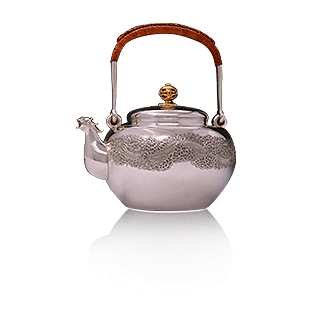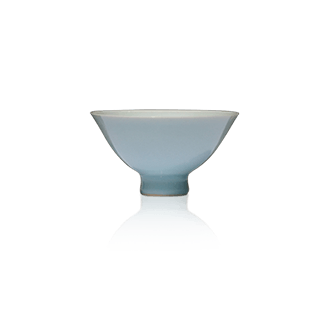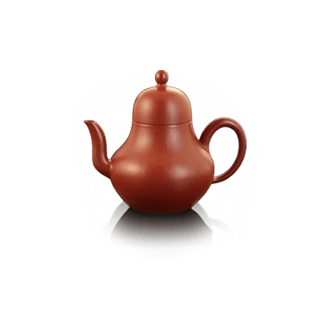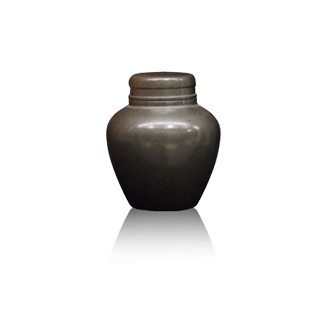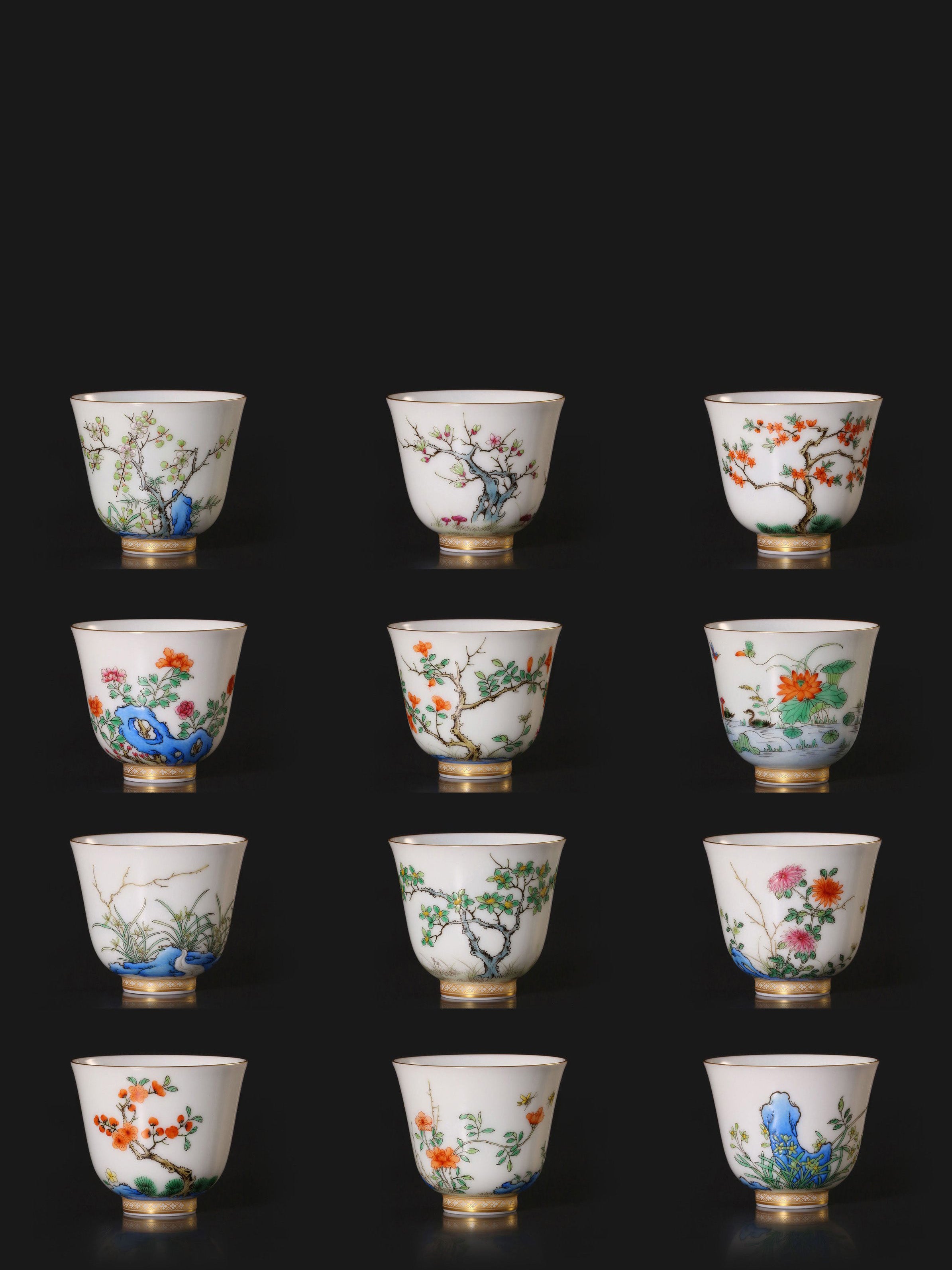
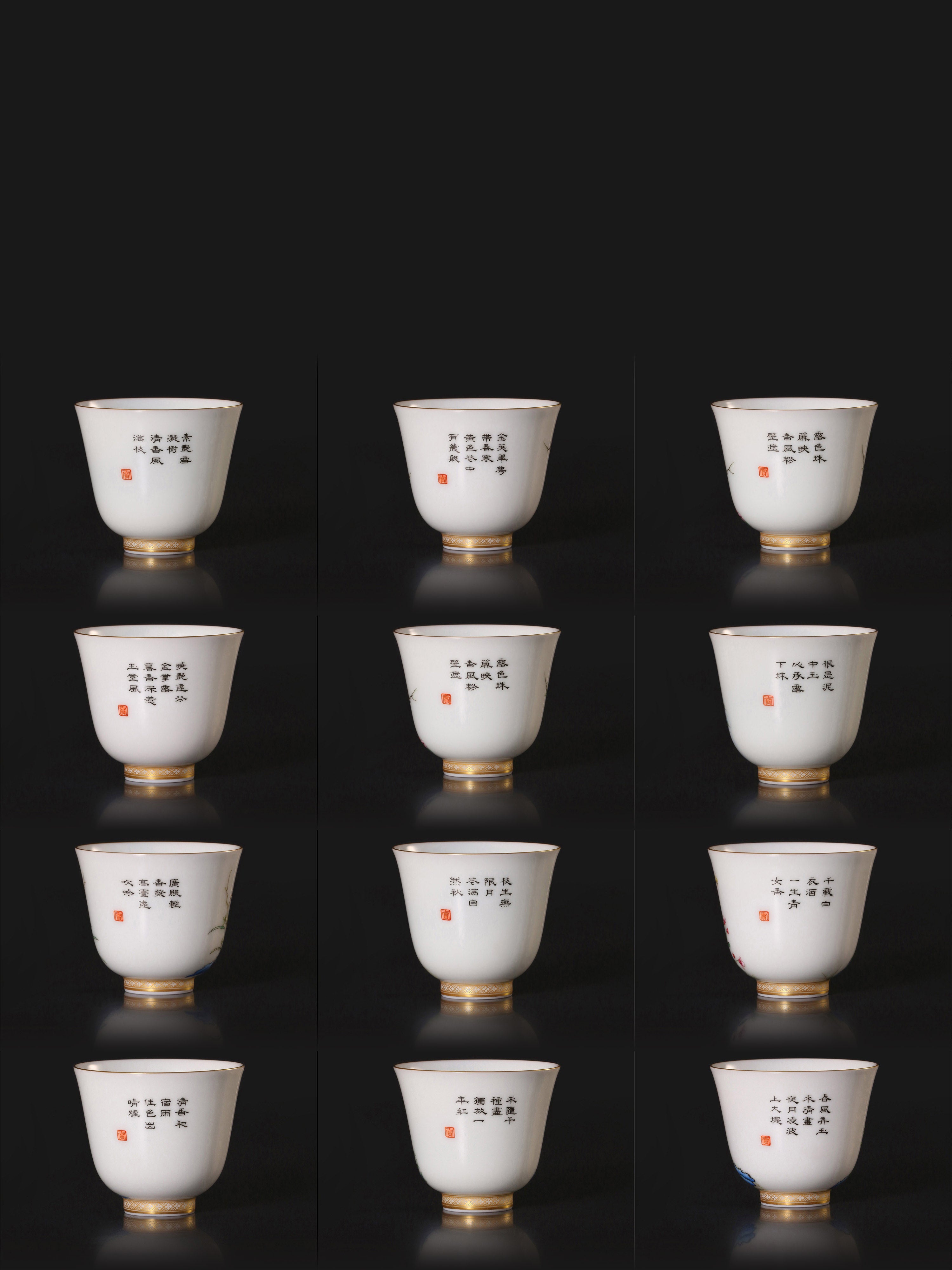
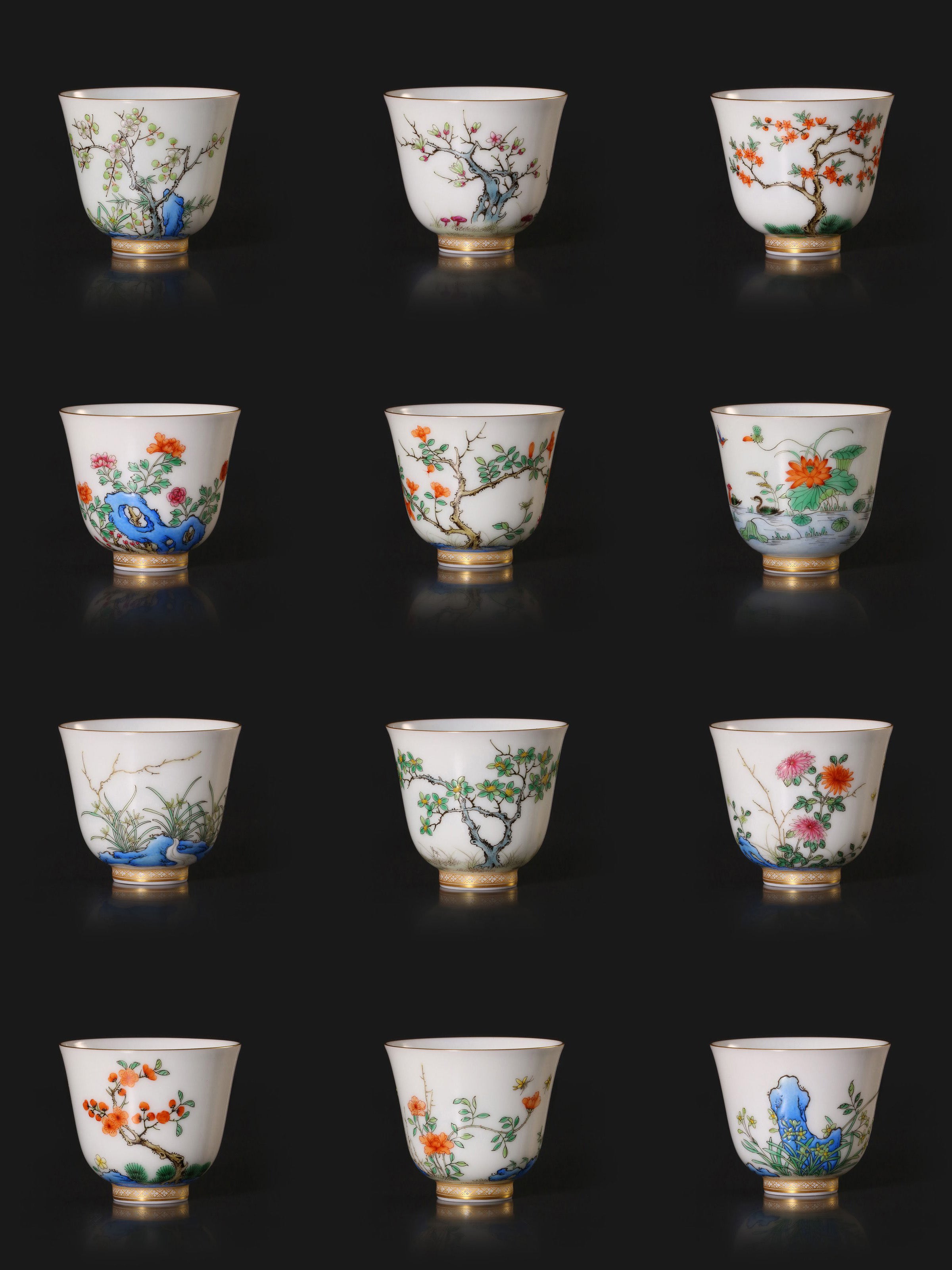
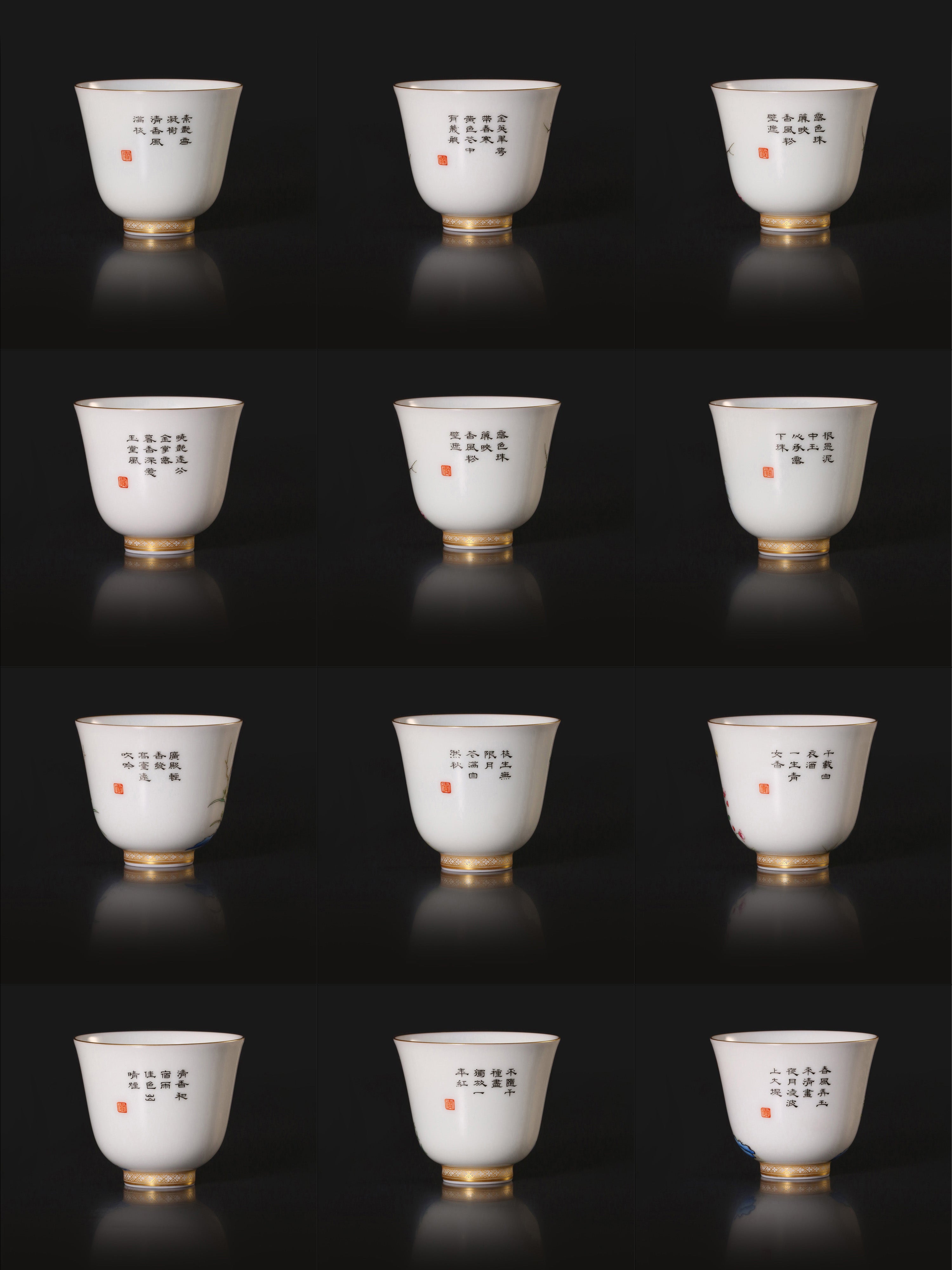
Kangxi Twelve Flower Goddess Cups






Kangxi Twelve Flower Goddess Cups
Kangxi Twelve Flower Goddess Cups
Vessel Type: Flora Cup
Artist: dayatang / Xu Zhijun, Jingdezhen ICH Inheritor of Famille-Rose Porcelain
Material: Porcelain )
Specifications: Diameter: 6.5cm (Diameter) Height: 5.8cm (Overall height)
Vessel Type: Flora Cup
Artist: dayatang / Xu Zhijun, Jingdezhen ICH Inheritor of Famille-Rose Porcelain
Material: Porcelain )
Specifications: Diameter: 6.5cm (Diameter) Height: 5.8cm (Overall height)
Kangxi Twelve Flower Goddess Cups
Just how elegant were the Twelve Flower Goddess Cups that captivated four generations of emperors?
Emperor Kangxi was very knowledgeable about and admired porcelain from various dynasties. In the nineteenth year of his reign (1680 AD), he ordered the restoration of the imperial kilns in Jingdezhen to produce various porcelains in new styles. Zang Yingxuan was appointed as the supervisor of porcelain production in Jingdezhen, marking the official start of production for the Qing Dynasty's imperial kilns.
In the 25th year of the Kangxi Emperor's reign, Liu Yuan was commissioned to design and produce the "Twelve Flower Goddess Cups" for the imperial kilns in Jingdezhen. These cups integrated poetry, calligraphy, painting, and seal carving, representing an innovation in Kangxi's imperial ware. Because the Kangxi Emperor greatly admired Tang poetry, the poems accompanying the twelve monthly flower goddess cups were all from Tang poems.
Among the hundreds of porcelain designs Liu Yuan created under imperial order, the Twelve Flower Goddess Cup was unprecedented and unparalleled.
Emperor Kangxi brought the cup with him on several of his southern tours. He not only appreciated the craftsmanship of the Flower Goddess Cup porcelain but also the cultural imagery of flowers paired with Tang poems.
The "Twelve Flower Goddess Cups" were imitated by both official and private kilns during the Yongzheng, Jiaqing, Guangxu, and Republican periods, with slight variations in size. The "Flower Goddess Cups" have developed into a historical brand. Each cup has been treasured by enthusiasts throughout history.

Plum Blossom Cup (January)
(Princess Shouyang, the Goddess of Plum Blossoms)
Pure white snow clings to the trees, their delicate fragrance fills the air.

Speaking of the Flower Goddess
Flowers embody the spirit and beauty of heaven and earth. To appreciate their beauty and understand their essence is to grasp their charm. "The plum blossom symbolizes purity, the orchid exudes fragrance, tea presents elegance, the plum blossoms adorn themselves, the apricot blossoms are delicate and graceful, the chrysanthemum defies the frost, the narcissus has icy skin and jade-like complexion, the peony is a national beauty, the jade tree stands tall and elegant, the golden lotus floats gently in the pond, the osmanthus fragrance drifts in the moonlit cave, and the hibiscus is cold and beautiful on the cold river." The nature and unique charm of each flower are fully revealed in this purity, tranquility, elegance, and beauty. The beauty of the plum blossom is described as "its cold beauty and pure fragrance are known by the snow, who wears wax as a garment in the rain?"; the beauty of the chrysanthemum is described as "when the Double Ninth Festival arrives, its branches proudly stand against the frost in a dream of prosperity"; the beauty of the orchid is described as "its fragrance travels far from the valley, how can it reach the mundane world?"
Throughout history, those who love and cherish flowers have naturally left behind many touching legends about them. Therefore, in China, each flower has its own flower deity and a beautiful story.
During the Ming Dynasty, Taoism had the concept of "flower goddesses". By the mid-Qing Dynasty, Yangliuqing New Year paintings began to feature a series of paintings of "flower goddesses", which used legendary and historical figures from the Tang and Song Dynasties to name the flower goddesses and represent the flower goddesses of each month.
Plum Blossom Goddess: Princess Shouyang
Princess Shouyang was the daughter of Emperor Wu of Song. She was naturally beautiful, pure and refined, and loved plum blossoms most of all. One year, on the seventh day of the first lunar month, Princess Shouyang went to the plum blossom grove in the palace to admire the blossoms. Feeling drowsy, she took a nap under the eaves of Hanzhang Hall. A plum blossom happened to fall on her forehead, leaving a five-petaled mark that could not be wiped away. The palace maids felt that this plum blossom mark added to the princess's charm, so they all imitated her, imprinting plum blossoms on their foreheads, a style known as "plum blossom makeup" or "Shouyang makeup." People then said that the princess was a plum blossom spirit in disguise, and thus Princess Shouyang became the flower goddess of plum blossoms.
Jiang Caiping, a concubine of Emperor Xuanzong of Tang, was also considered to be the goddess of plum blossoms. She loved plum blossoms and planted plum trees in the palace and built a plum pavilion for her own enjoyment. Therefore, Emperor Xuanzong bestowed upon her the title of "Plum Consort".

February Magnolia Cup
(Magnolia Flower Goddess Lijuan)
Golden blossoms and emerald calyxes carry the chill of spring; among the yellow flowers, several kinds...


Magnolia, also known as magnolia, is a flower that closely resembles a lotus in appearance. When in full bloom, its petals spread out in all directions, exuding nobility and elegance, and emitting a pleasant fragrance. Magnolias have been cultivated in my country since the Spring and Autumn Period. The great poet Qu Yuan wrote in "Li Sao," "In the morning I drink the dew that falls from the magnolia, in the evening I eat the fallen petals of the chrysanthemum," to praise the noble character of the magnolia.
Magnolia Flower Goddess: Lijuan
She was a favored palace woman of Emperor Wu of the Western Han Dynasty. Her skin was soft and her breath was like orchids. She once sang the song "Returning Wind" next to the Zhilan Palace, and the flowers in the courtyard fell down as a result, which is known as "Flying Flowers in the Curved Courtyard".

Peach blossoms in March
(Lady Peach Blossom Goddess)
The wind and flowers herald the new spring, the season is old and spring is in full bloom.

Peach Blossom Goddess: Lady Xi
Lady Xi was the wife of the Marquis of Xi in the State of Chu during the Spring and Autumn Period. The Marquis of Xi was killed in a coup by King Wen of Chu. King Wen, captivated by Lady Xi's beauty, attempted to force her into marriage. Lady Xi refused and secretly left the palace to find the Marquis. The Marquis committed suicide, and Lady Xi followed him in death. This occurred in March, when peach blossoms were in full bloom. The people of Chu, moved by Lady Xi's steadfastness, erected a shrine to worship her, also calling her the Goddess of Peach Blossoms.


April Peony Cup
(Empress Wu Zetian, the goddess of peonies)
The morning glow shines brightly, like dew on a golden palm; the evening fragrance lingers in the jade hall.

Peony Flower Goddess: Wu Zetian
Peonies symbolize wealth, peace, prosperity, and flourishing. Wu Zetian was a politician from the Tang Dynasty to the Wu Zhou Dynasty, the only legitimate female emperor in Chinese history, and one of the longest-reigning emperors. She ascended the throne, changed the dynasty name to Zhou, established her capital in Luoyang, and founded the Wu Zhou Dynasty. During her reign, Wu Zetian was known for her keen insight, decisive judgment, and ability to appoint capable people. She established the palace examination, the military examination, and the system of examiners, emphasizing the selection of talent. Furthermore, Wu Zetian possessed exceptional intelligence and strategic acumen, was well-versed in literature and history, and had considerable poetic talent. The "Deposing the Empress and Establishing Wu" event had a profound impact on Chinese history.

May Pomegranate Flower Cup
(Lady Pan, the Goddess of Pomegranate Flowers)
Dew-kissed beads reflect in the curtain, fragrant breezes veil the pink walls.



Pomegranate Flower Goddess: Lady Pan
When Empress Pan was still a lady, Sun Quan often took her with him to visit Zhaoxuan Terrace. Feeling blissful and slightly drunk, Lady Pan spat her wine into a jade pot and ordered her maid to empty it outside the platform. Only a ruby ring fell out of the tilted pot. Lady Pan then hung the ring high on a pomegranate branch. The high platform built on this spot was called "Huanliu Terrace" (Ring Pomegranate Terrace). At the time, some advised against this, saying, "During the Wu-Shu rivalry, the name 'Huanliu' sounds like 'returning Liu,' which would bring ominous signs." Therefore, it was renamed "Liuhuan Terrace" (Pomegranate Ring Terrace). Because Lady Pan possessed the Liuhuan Terrace, symbolizing a beautiful face, pomegranate blossoms, and a red ring reflecting each other, later generations regarded Lady Pan as the flower goddess of the pomegranate blossoms in May.
Some say that Gongsun Da Niang was the goddess of pomegranate flowers, while others claim she was more. Gongsun Da Niang was one of the most outstanding dancers of the Tang Dynasty, renowned for her sword dance. She created various sword dances based on traditional techniques, such as the "Xihe Sword Dance" and the "Sword Dance with a Hollow Edge." The famous Tang Dynasty poet Du Fu described her sword dance: "Once there was a beautiful woman named Gongsun, whose sword dance moved all directions. Spectators were as numerous as mountains, their faces downcast; heaven and earth seemed to bow low. Swift as Yi shooting down nine suns, graceful as emperors riding dragons. Coming like thunderbolts gathering their fury, ending like the calm light of the sea." It is said that Zhang Xu, the master of cursive script, drew inspiration from her sword dance. Her flowing, unpredictable dance was like a pomegranate blossom.

June Lotus Cup
(Xi Shi, the Lotus Goddess)
The roots are like jade in the mud, and the heart receives pearls from the dew.

Lotus Goddess: Xi Shi
She is considered the foremost of the Four Beauties of ancient China. Originally named Shi Yiguang, she was a washerwoman from Zhuji's Zhuluo Village at the foot of Mount Zhuluo. She was naturally beautiful and exceptionally gifted. Legend has it that after the fall of the Wu Kingdom, Xi Shi sailed away with Fan Li on a small boat across the Five Lakes.

July Orchid Cup
(Orchid Goddess Su Xiaoxiao)
A light fragrance wafts from the grand hall, and distant melodies drift from the high terrace.


Orchid Goddess: Su Xiaoxiao
Her life is not well documented, but it is said that she was a famous courtesan in Qiantang during the Southern Qi Dynasty. After her death, she was buried near Xiling Bridge, where a stone tablet was erected that read: "Tomb of Su Xiaoxiao of Qiantang." "Jade was buried here by the lake and mountains, and her beauty could be cast in gold."

August Osmanthus Cup
(Osmanthus Goddess Green Pearl)
Branches grow endlessly under the moon, flowers bloom in natural autumn.

Osmanthus Goddess: Green Pearl
Green Pearl, according to legend, was originally surnamed Liang and was born at the foot of Shuangjiao Mountain in Baizhou. She was skilled at playing the flute. When the wealthy Shi Chong served as the Inspector of Jiaozhi, he sought Green Pearl from the local governor, who asked for her. The governor asked for a bushel of pearls, but Shi Chong readily exchanged ten bushels of pearls for her, hence the saying, "The Shi family's Golden Valley resounds anew, ten bushels of pearls bought a beautiful woman." Shi Chong was arrogant and extravagant, yet he doted on Green Pearl. Later, Jia Mi, the court official to whom Shi Chong relied, was executed, and Shi Chong was dismissed from his post. Sun Xiu, who had always coveted Green Pearl, demanded her from Shi Chong, but was refused. He then advised the powerful Prince Zhao Lun to execute Shi Chong. When the soldiers arrived, Shi Chong sighed to Green Pearl, "I have been punished because of you." Green Pearl wept and said, "I am willing to die before you." Then she jumped to her death.


September Chrysanthemum Cup
(Li Qingzhao, the Chrysanthemum Goddess)
A thousand years of white-robed wine, a lifetime of Qingnu fragrance.

Chrysanthemum Goddess: Li Qingzhao
Chrysanthemums symbolize purity, nobility, true feelings, and elegance. Li Qingzhao, a female poet of the Song Dynasty and a representative of the graceful and restrained style of poetry, is hailed as the greatest female talent of all time. Born into a scholarly family, Li Qingzhao enjoyed a privileged childhood and a strong foundation in literature. Growing up surrounded by art, she developed exceptional talent, rivaling even her predecessors. After the Jingkang Incident, she endured hardship and displacement, and her poetry shifted from a carefree and leisurely tone to one of sorrow and lamentation.


October Apricot Blossom Cup
(Yang Yuhuan, the Goddess of Apricot Blossoms)
A delicate fragrance mingles with the lingering rain, and beautiful colors emerge from the clear mist.

Apricot Blossom Goddess: Yang Yuhuan
Yang Yuhuan, one of the Four Beauties of ancient China, was renowned for her beauty, singing, dancing, and musical talent. She was a court musician and dancer during the Tang Dynasty. Her beauty was described as captivating, "A single glance from her could launch a thousand ships, eclipsing all the other beauties in the palace." However, she was later killed during the An Lushan Rebellion at Mawei Slope at the age of thirty-eight. After the rebellion was quelled, Emperor Xuanzong sent people to retrieve her remains for reburial. There, they found a field of white apricot blossoms fluttering in the wind. Xuanzong then ordered Taoist priests to search for Yang Guifei's spirit, who was found to be on a celestial mountain, now the goddess of apricot blossoms.


November Rose Cup
(Wang Zhaojun, the Rose Goddess)
Not fading with a thousand kinds of flowers, it alone blooms red for a year.

Rose Goddess: Wang Zhaojun
A native of Zigui in Nanjun, she was selected as a "daughter of a good family" to enter the imperial harem during the reign of Emperor Yuan of Han. Legend has it that because she refused to bribe the court painter Mao Yanshou, he added a mole depicting a widowed woman's tear on her portrait, thus preventing her from ever seeing the emperor again. After Zhaojun's departure for the Xiongnu, the Han and Xiongnu peoples lived in harmony and peace, and the country prospered. "The border cities were peaceful and quiet, cattle and horses grazed freely in the fields, and for three generations there was no alarm of barking dogs; the common people forgot the horrors of war," showcasing a thriving and peaceful scene.


December Narcissus Cup
(Narcissus Goddess Mi Fei)
Spring breezes play with jade, bringing clear books; the night moon glides across the waves, rising above the great dike.

Narcissus: It blooms only in December, once a year. The "History of Vases" calls it an elegant guest among flowers.
Narcissus Goddess: Mi Fei
Ancient texts often mention the Luo River and the Goddess of the Luo River: "I happened to meet the Goddess of the Luo River in the dead of winter, and I stood alone, thinking that spring had come first." "The River Goddess was about to ride the waves, and the Han woman returned with her jade pendant." "Who is the romantic Chen Si Ke? I can only imagine the people of the Luo River back then."
In "Ode to the Goddess of the Luo River", Cao Zhi describes Zhen Mi's beauty, comparing her to a fairy of the Luo River: "Her form is like a startled swan, graceful as a swimming dragon, faintly like light clouds veiling the moon, drifting like swirling snow in the wind."
Later generations likened the daffodil to Mi Fei, the water fairy in mythology.





Frequently asked questions
Use the FAQ section to answer your customers' most frequent questions.
Order
Yes, we ship all over the world. Shipping costs will apply, and will be added at checkout. We run discounts and promotions all year, so stay tuned for exclusive deals.
It depends on where you are. Orders processed here will take 5-7 business days to arrive. Overseas deliveries can take anywhere from 7-16 days. Delivery details will be provided in your confirmation email.
You can contact us through our contact page! We will be happy to assist you.





